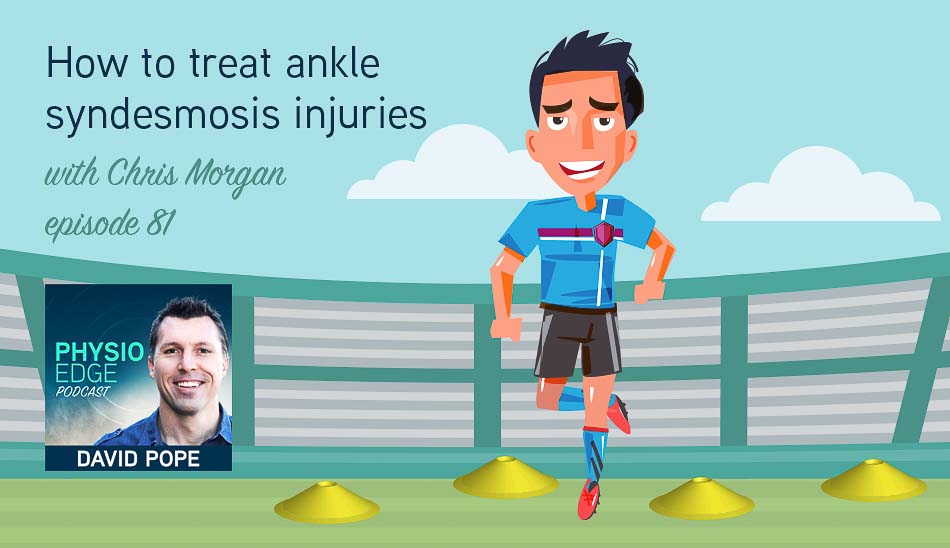
Ankle syndesmosis injuries following forced ankle dorsiflexion and lateral rotation of the foot require very specific management and rehabilitation to achieve great treatment outcomes. If you approach management of ankle syndesmosis injuries in the same manner as a lateral ankle ligament injury it will likely result in long term pain and dysfunction for your patients.
In the previous episode of the Physio Edge podcast - How to assess ankle syndesmosis injuries, Chris Morgan and David Pope explored how to assess and diagnose ankle syndesmosis injuries (ASI).
In this new Physio Edge podcast - "How to treat ankle syndesmosis injuries with Chris Morgan (Arsenal 1st Team Physiotherapist in the English Premier League), you will discover how to manage different grades of ASI, including:
Grade 1 syndesmosis injury management
- Initial injury management
- How long should you immobilise a Grade 1 injury for?
- What weight bearing should be allowed in the initial stages?
- Taping techniques that can be utilised during return to running, training and play
- Rehab - initial exercises and progressions
- How much pain is acceptable during return to training?
- Return to sport timeframes & how you and your athlete can decide when RTP is appropriate
- When can contact be initiated?
Grade 2 syndesmosis injuries
- Grade 2 injury management and immobilisation
- Which players are likely to require arthroscopy to confirm instability, and subsequent stabilisation surgery?
- Why rehabilitation of stable grade 2 injuries is different from grade 1 injuries
- Which movements you need to restrict
- How to maintain lower limb musculature and minimise muscle atrophy should be performed
- Additional general conditioning your patient should perform during the early phase of rehab
- How to incorporate an Alter G treadmill into rehab
- Occlusion training for lower limb conditioning
- How to modify rehab if you do not have access to an Alter G
- Timeframes and criteria to assess when your patient can remove their immobilisation boot
- Tests to perform at each stage of rehab
- When and how should dorsiflexion range be improved?
- Timeframes and criteria to meet prior to return to running
- Exercise progressions and variations
- Return to play markers and tests you can use
- What to do when a player still reports a ‘nipping’ at the front of the ankle after 6 weeks and is having difficultly achieving full dorsiflexion
Unstable injuries - Grades 2b, 3 and 4
- Management of unstable injuries
- Post-surgical immobilisation and management
- Common return to play timeframes
To accurately grade your patients ASI and prescribe the most appropriate rehab I strongly recommend listening to Physio Edge podcast episode 80 – How to assess ankle syndesmosis injuries with Chris Morgan prior to this podcast.
Free webinar - Medial knee injuries with Chris Morgan
Medial knee injuries often occur in snow sports, or other sports when landing or being tackled. Different areas of the medial knee can be injured, including the deep, superficial, proximal or distal fibres of the MCL and medial knee. Depending on the injured structures, patients will either cope with a more aggressive treatment approach and early return to sport, or require a more conservative approach. How can you know the rehab approach your individual patient requires?
In this free webinar with Chris Morgan (1st Team Physiotherapist with Arsenal FC), you will explore:
- Applied anatomy of the medial knee
- Mechanism of injury, presentation and diagnosis of medial knee injuries
- How you can differentiate between deep, superficial, proximal, distal and Grade 1, 2 and 3 clinical injuries
- How imaging findings correlate with your clinical findings
- MRI grading (radiological versus clinical)
- How you can perform an objective assessment
- How function, pain and instability impact your treatment
- Accelerated vs more conservative treatment - how can you choose the ideal approach for your patient?
- Are PRP injections appropriate?
- Rehabilitation principles you can use with your medial knee injury patients
- Ligament loading
- Which bracing and weight bearing regime should you utilise?
- What should you do when your patient has joint laxity?
- Is pain during rehab acceptable?
- Should you overload OR "under load to overcome"?
Click here to access this webinar with a free trial Clinical Edge membership

Links associated with this episode:
- Twitter - @ChrisMorgan10
- Let David Pope know what you liked about this podcast on Twitter
- Review the podcast on iTunes
- Like the podcast on Facebook
- Infographics by Clinical Edge



